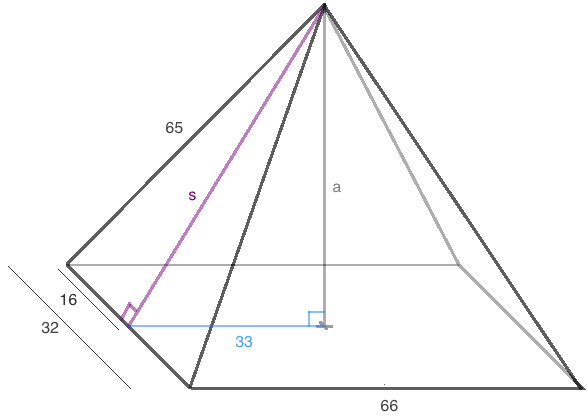Let half the width of the rectangle = w
Then half the length of the rectangle = √[ 1 - w2 ]
And let the area of the rectangle = A
\(A\ =\ 4w\sqrt{1-w^2}\\~\\ \frac{dA}{dw}\ =\ 4\frac{d}{dw}\big(w\sqrt{1-w^2}\,\big)\\~\\ \frac{dA}{dw}\ =\ 4\Big[(w)(\frac12)(1-w^2)^{-\frac12}(-2w)+(\sqrt{1-w^2})(1)\Big]\\~\\ \frac{dA}{dw}\ =\ 4\Big[\frac{-w^2}{\sqrt{1-w^2}}+\sqrt{1-w^2}\Big]\\~\\ \frac{dA}{dw}\ =\ 4\Big[\frac{-w^2}{\sqrt{1-w^2}}+\frac{1-w^2}{\sqrt{1-w^2}}\Big]\\~\\ \frac{dA}{dw}\ =\ \frac{4-8w^2}{\sqrt{1-w^2}}\)
Now let's find what value of w makes \(\frac{dA}{dw}\) be 0 .
\(0\ =\ \frac{4-8w^2}{\sqrt{1-w^2}}\\~\\ 0\ =\ 4-8w^2\qquad\text{and}\qquad\sqrt{1-w^2}\ \neq\ 0\qquad\text{that is}\qquad w\ \neq\ \pm1\\~\\ 8w^2\ =\ 4\\~\\ w^2\ =\ \frac12\\~\\ w\ =\ \sqrt{\frac12}\qquad\text{or}\qquad w\ =\ -\sqrt{\frac12} \)
We know half the width of the rectangle can't be negative,
and by looking at a graph https://www.desmos.com/calculator/txezockcml
we can confirm that the maximum value of A occurs when \(w=\sqrt{\frac12}\) .
When \(w=\sqrt{\frac12}\) ,
\(A\ =\ 4w\sqrt{1-w^2}\ =\ 4\sqrt{\frac12}\sqrt{1-\frac12}\ =\ 4\sqrt{\frac12}\sqrt{\frac12}\ =\ 4\cdot\frac12\ =\ 2\)
The maximum area is 2 sq units.
(1)

Here, s is a slant height and a is the altitude.
We can find s with the Pythagorean theorem.
s2 + 162 = 652
s2 = 652 - 162
s2 = 3969
s = 63
Now we can find a with the Pythagorean theorem.
a2 + 332 = s2
a2 + 332 = 632
a2 = 632 - 332
a2 = 2880
a = √[ 2880 ]
a = 24√5
*****edit*****
My original answer for lateral area wasn't right because I didn't take into account that the faces aren't all the same.
The same way we found s , we can find the length of the other slant height.
other slant height = √[ 652 - 332 ] = 56
lateral area = 2 * (1/2) * 32 * 63 + 2 * (1/2) * 66 * 56 = 32 * 63 + 66 * 56 = 5712 square units
And we can check this answer with this handy dandy calculator: here
**************
volume = (1/3) * area of base * altitude
volume = (1/3) * (32 * 66) * a
volume = (1/3) * (32 * 66) * 24√5
volume = 16896√5 cubic units
If you have a question about where any of these numbers came from please ask ![]()
We're given a point and a slope so we can easily write the equation of the line in point-slope form.
The equation of the line in point-slope form is....
y - -4 = -\(\frac38\)(x - 5)
Now we just need to get this equation into standard form.
The standard form of a line is Ax + By = C where A is a positive integer, and B and C are integers.
y - -4 = -\(\frac38\)(x - 5)
y + 4 = -\(\frac38\)(x - 5)
Multiply both sides of the equation by 8 .
8(y + 4) = -3(x - 5)
Distribute the 8 and the -3
8y + 32 = -3x + 15
Add 3x to both sides of the equation.
3x + 8y + 32 = 15
Subtract 32 from both sides.
3x + 8y = -17
Now the equation is in standard form. Here's a graph: https://www.desmos.com/calculator/momem4spgv